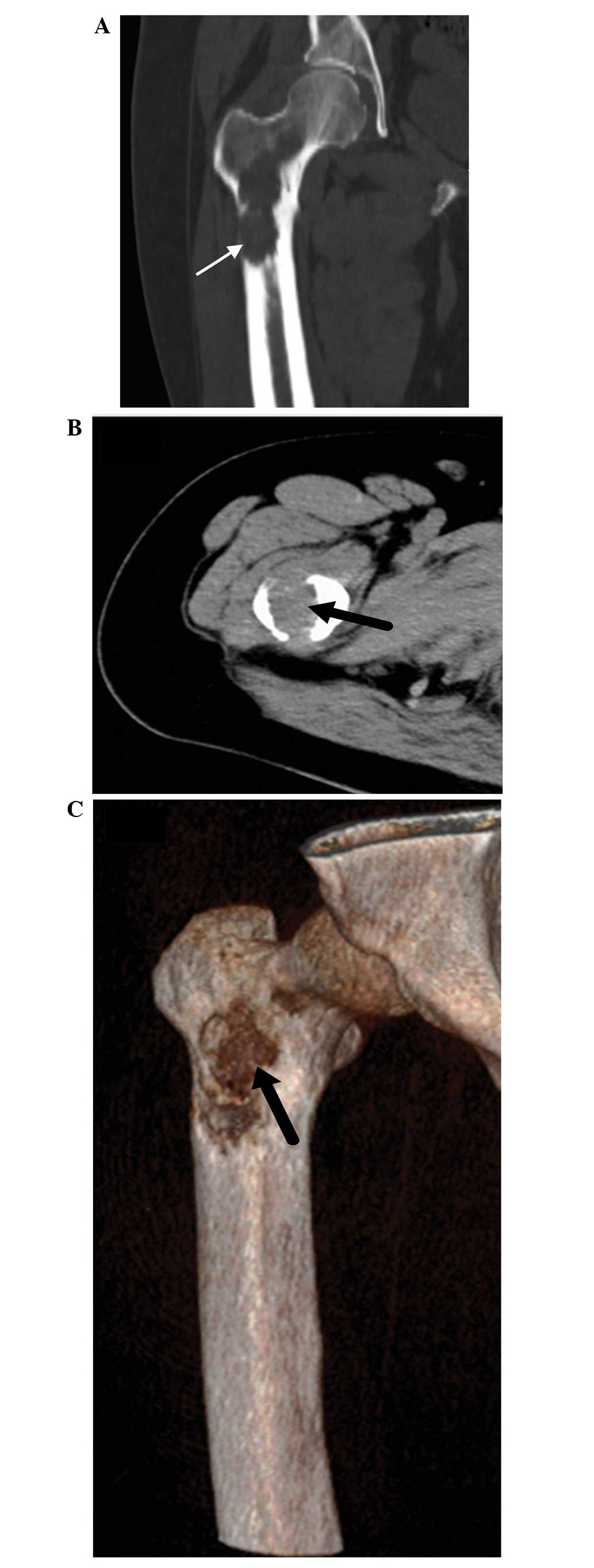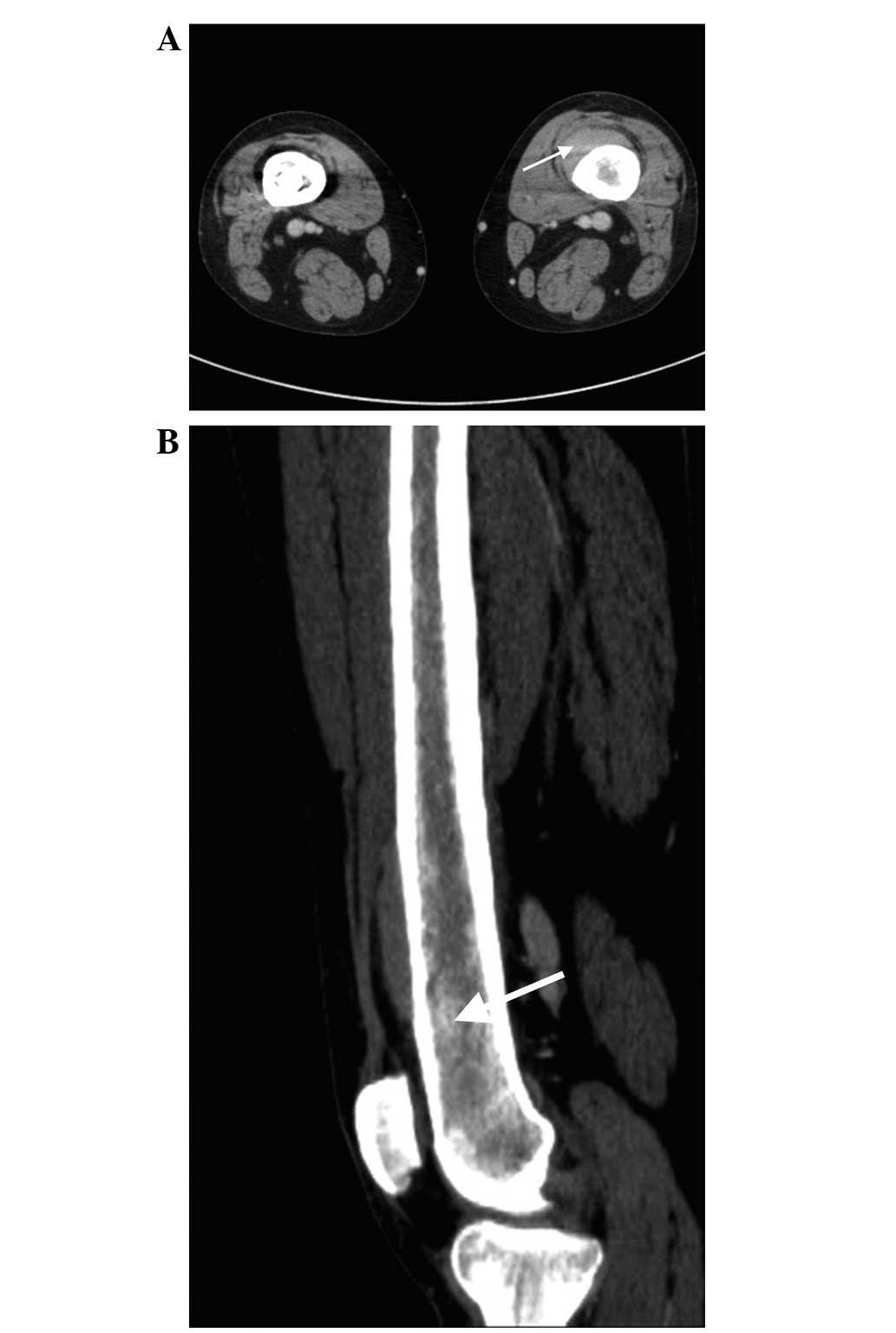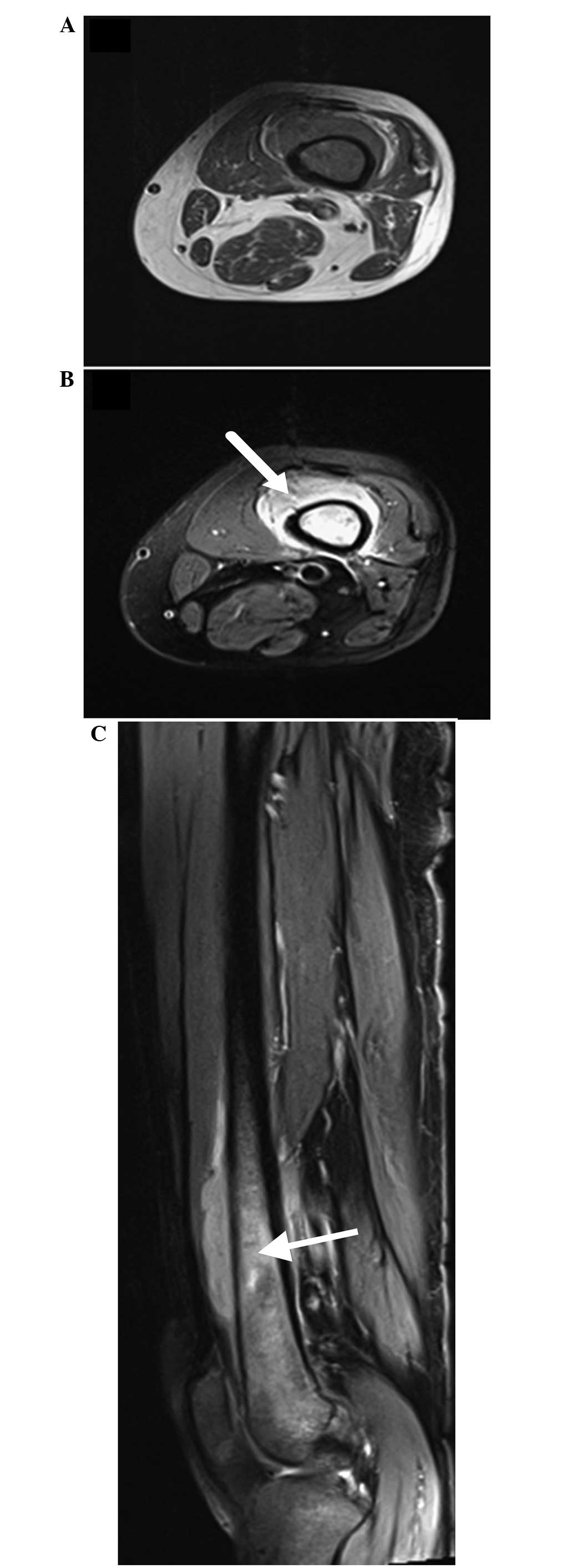Primary alveolar soft part sarcoma of the right femur and primary lymphoma of the left femur: A case report and literature review
- Authors:
- Published online on: November 10, 2015 https://doi.org/10.3892/ol.2015.3906
- Pages: 89-94
-
Copyright: © Cao et al. This is an open access article distributed under the terms of Creative Commons Attribution License.
Abstract
Introduction
Alveolar soft part sarcoma (ASPS) is a rare soft tissue tumor that accounts for ~0.5–1.0% of all soft tissue sarcomas (1). ASPS was first described in 1952, and has rarely been reported since (2). ASPS involves several locations, particularly muscles and deep soft tissues of the body (3). In adults, ASPS is often localized in the lower extremities, while the head and neck are the predominant sites for ASPS in children (4). Park et al reported six cases of primary ASPS of bone in 1999, and demonstrated the bone origin of this condition based on their radiological findings (5). To date, the number of published studies reporting cases of ASPS is limited (3,6,7).
Primary lymphoma of bone (PLB) is an extranodal lymphoma that arises from the medullary cavity and manifests as a localized, solitary lesion (8). PLB represents 3% of all primary malignant bone tumors, and 1% of all malignant lymphomas (8). First reported by Oberling in 1928 (9), PLB has been described as a malignant, lymphoid infiltrate within bone, with or without cortical invasion or soft tissue extension, and without concurrent involvement of regional lymph nodes or distant viscera (10). Non-Hodgkins lymphoma constitutes the majority of PLBs, and the most common subtype is diffuse large B-cell lymphoma (11,12), while T-cell PLB is rare (13).
Second primary malignances (SPMs) are newly developed malignant neoplasms that present synchronously or metachronously in a patient with a known malignant disease (14). The incidence of SPM is not rare (15–18). However, a limited number of cases of primary intraosseous ASPS and PLB have been reported in the literature thus far. To the best of our knowledge, the present report is the first case of intraosseous ASPS and PLB occurring concomitantly in the same patient. Written informed consent was obtained from the patient.
Case report
A 42-year-old woman presented to the Department of Radiology of Zhongnan Hospital of Wuhan University (Wuhan, China) with continuous pain in her right hip and occasional pain in her left leg, in addition to dizziness and heart palpitations. The patient had been experiencing these symptoms during the two months prior to the date of admission to the hospital in June 2010.
The results of a blood routine test performed prior to the date of admission suggested anemia, and the patient had been receiving treatment for anemia during one month at her local hospital, but the pain in her right hip worsened. Therefore, the patient was referred to the Zhongnan Hospital of Wuhan University. Physical examination identified a firm mass with a poorly delineated margin that was palpable in the right hip. The left leg examinations did not indicate any abnormalities. The red blood cell count was 2.23×1012 cells/l, and the levels of hemoglobin were 66.20 g/l. The patients initial pelvic radiograph revealed a large right proximal femur osteolytic process with cortical disruption (Fig. 1). Computed tomography (CT) confirmed the presence of a large non-matrix producing soft tissue lesion in the right proximal femur, which was accompanied of cortical destruction, but did not exhibit surrounding sclerosis or associated periosteal reaction (Fig. 2).
Following tumor resection, the patient received bone cement and was subjected to internal fixation. Microscopic examination of the tumor specimen by hematoxylin and eosin stain (ZSGB-BIO, Beijing, China) revealed proliferation of large polygonal cells separated by thin fibrous septa. The cells presented round nuclei, were disposed centrally, and contained abundant granular eosinophilic cytoplasm. A small number of normal mitoses were also observed (Fig. 3). On immunohistochemistry, the tumor cells were diffusely positive for myoglobin and cytokeratin, focally positive for Ki-67, and negative for cluster of differentiation (CD)138, CD79a, CD20, CD3, CD30, anaplastic lymphoma kinase and chromogranin A (CgA). Consequently, the patient was diagnosed with ASPS of the right proximal femur.
The patient initiated chemotherapy treatment with adriamycin (A) and ifosfamide (I) at 20 days post-surgery. The AI protocol consisted of 4-day administration of ifosfamide at a dose of 3 g/m2, and 3-day administration of adriamycin at a dose of 60 mg/m2. In addition, the patient received adequate mesna for protection and hydration. The treatment was effective in treating the symptoms, and the patient achieved IV degree of bone marrow suppression. The second round of chemotherapy started three weeks later, and following four weeks, the patient accepted radiotherapy with total doses of 60 Gy/200 cGy/30 fraction/40 day. During this period, the patient complained of persistent pain in the left leg.
The subsequent X-ray examination was normal (Fig. 4), but plain CT scan revealed a focus of marrow replacement, surrounded by a soft tissue mass without cortical bone destruction (Fig. 5). The soft tissue mass displayed homogeneous texture, sharp margins and mild enhancement surrounding the right femoral cava, while the marrow replacement exhibited heterogeneous enhancement upon administration of contrast medium (Fig. 6). Magnetic resonance imaging (MRI) demonstrated a clearer lesion extent of marrow replacement, which presented equal signal intensity on T1-weighted imaging and bright signal intensity on T2-weighted imaging. The surrounding soft tissue mass displayed the same signal intensity (Fig. 7).
According to the clinical manifestations and radiological features, second primary tumor of bone rather than metastatic tumor was hypothesized. Following limb salvage treatment, microscopic examination of the specimen revealed that the tumor cells aligned diffusely with remarkable heteromorphism (Fig 8), and the adjacent striated muscles were invaded. Immunohistochemical examination demonstrated the tumor to be leukocyte common antigen+, CD99+, vimentin−, desmin−, melanoma−, synaptophysin−, pancytokeratin−, CgA−, CD3−, CD43+, CD20− and CD79a−. The pathological diagnosis was established to be peripheral T-cell lymphoma with the invasion of adjacent striated muscles.
According to the clinical manifestation and pathological results, the final diagnosis was ASPS of the right femur and PLB of the left femur. The patient then received radiotherapy, and was followed up for 4 years. To date, there is no evidence of bone marrow aspiration or abnormal laboratory results.
Discussion
In the present study, the case of a 42-year-old woman diagnosed with ASPS and PLB is reported. The patient underwent en bloc surgical resection, chemotherapy and radiotherapy, and remains currently alive.
The ASPS was located in the right femur, and had invaded the surrounding muscle. This is an unusual location for this tumor in an adult, according to previous reports (3,5). Certain clinical signs and symptoms exhibited by the patient were also considered unusual, such as the results of blood routine test, which suggested anemia.
The microscopic features of tumor cells do not tend to vary from tumor to tumor, and this uniformity is one of the characteristics of ASPS (19). The radiological features of primary bone manifestations of ASPS have been previously described by Park et al (5). A common feature in all the cases of ASPS reported by these authors was the detection of bone destruction with poorly defined tumor margins and epicenter located in the bone, indicating that the tumors occurred primarily in bone. Previous studies have demonstrated that ASPS is distinguishable at equal or slightly increased signal intensity relative to skeletal muscle on T1-weighted MRI, and displays high and heterogeneous signal intensity on T2-weighted MRI. In addition, the administration of intravenous contrast medium results in strong, uniform enhancement of tumor imaging (20). Tumor hypervascularity is characterized by findings such as serpentine flow voids, due to peripheral feeding and intratumoral vessels (20). In the present case report, X-ray examination revealed a large right proximal femur osteolytic process with cortical disruption, and CT scan confirmed the presence of a large non-matrix producing soft tissue lesion of the right proximal femur, which exhibited cortical destruction, but no surrounding sclerosis or associated periosteal reaction were observed. Cross-sectional imaging demonstrated that the epicenter was located in the right femur, and the intraosseous soft tissue mass was similar in size to the extraosseous component (19). This evidence supported the hypothesis that the tumor originated in bone.
In conclusion, the clinical symptoms of ASPS experienced by the patient of the present case report were not typical, and imageological diagnosis was the fastest way of confirming the disease, since MRI is the most effective method to determine the dimension of bone destruction and hypervascularity (20). Therefore, ASPS should be considered in the differential diagnosis of bone-originating highly vascularized soft tissue masses.
Currently, there is no consent definition or diagnostic criteria for PLB (10–12,21–25). It has been previously proposed that there may be lymph node involvement if there is a 6-month window between the time of diagnosis of the primary bone focus and the emergence of lymph node disease (21). The diagnosis of PLB may be challenging, since, it is often difficult to differentiate clinically PLB and lymphomatous involvement of bone as a component of extraosseous lymphoma (22,23). The patient of the present case report presented a primary focus in a single bone, which was confirmed histologically. However, there was no evidence of distant lymph node or metastasis to meet the diagnosis criterion. In the present case, the most typical symptom of PLB displayed by the patient was bone pain not relieved by rest, which was insidious and intermittent, similarly to a previous case reported in the literature (21).
PLB is mainly of B-cell origin (10). However, the pathological diagnosis of the patient in the present case report was established to be peripheral T-cell lymphoma of the left femur. Although T-cell PLB has been previously described, its incidence is rare, with the exception of Japan and Hong Kong, where the disease is more common, possibly due to the higher overall incidence of T-cell lymphoma in these countries (24).
The radiological features of PLB are variable and nonspecific (20–22). Conventional radiography typically reveals an osteolytic pattern of bone destruction, but may instead reveal a sclerotic or mixed lytic and sclerotic pattern, or may be normal in 5% of the cases. In the present case, the results of X-ray examination were normal. Previous studies have reported that periosteal reaction is typically minimal in PLB, despite extreme medullary infiltration (20–22). In addition, the presence of soft tissue masses is common in PLB, but these are better detected by cross-sectional imaging (24), since CT may reveal soft tissue extension, cortical involvement, or marrow invasion suggestive of malignancy, but these findings are nonspecific (20–22). Radionuclide bone scans are abnormal in the majority of patients with PLB (98%), demonstrating mild to marked increased uptake (22). Positron emission tomography may be aid in staging or detecting residual disease following treatment, but does not contribute to the initial diagnostic examination of suspected PLB (25). In MRI, the characteristic signals of PLB tend to be heterogeneous and variable, and the majority of lesions appear isointense or hypointense compared with muscle on T1, and hypo, iso or hyperintense compared with subcutaneous fat on T2 (20,23,26). The low intensity of the lesion signals on T1 and T2 is speculated to be associated with a high content of fibrous tissue in patients with PLB (26). Furthermore, enhancement patterns in PLB are usually heterogeneous (26). Soft tissue extension is present in the majority of cases of PLB, and generally exhibits the same signal intensity than the bone lesion (26). Intramedullary extension is best assessed on MRI, since a clear line of demarcation with normal marrow is usually observed (23). PLB is rarely confined to the periosteum or cortex with diffuse cortical thickening without medullary involvement (23).
With the development of effective oncological treatments, surgery is no longer required in the management of PLB (11). Therefore, an accurate diagnosis is required in order to avoid unnecessary surgical procedures. Biopsy and imaging studies are effective for the diagnosis of PLB, since MRI is the most sensitive technique for the detection of intraosseous tumors (23).
In summary, the case of a 42-year-old woman with SPM has been reported in the present study. To the best of our knowledge, this is the first case of ASPS in the right femur and PLB in the left femur occurring concomitantly in the same patient to date. These two types of tumors present different inherent imageology characteristics. The review of the literature conducted in the present study identified that the incidence of SPMs is not rare (15–18). Therefore, when the radiographic signs are unexpected, the possibility of a second primary tumor should be considered.
References
|
Weiss SW and Goldblum: Malignant soft tissue tumors of uncertain type. Enzinger and Weisss Soft Tissue Tumors (5th). (Philadelphia). Mosby Elsevier. 1182–1191. 2008. | |
|
Christopherson WM, Foote FW and Stewart FW: Alveolar soft-part sarcomas; structurally characteristic tumors of uncertain histogenesis. Cancer. 5:100–111. 1952. View Article : Google Scholar : PubMed/NCBI | |
|
Zhu FP, Lu GM, Zhang LJ, Wang JD, An XJ and Dong YC: Primary alveolar soft part sarcoma of vertebra: A case report and literature review. Skeletal Radiol. 38:825–829. 2009. View Article : Google Scholar : PubMed/NCBI | |
|
van Ruth S, van Coevorden F, Peterse JL and Kroon BB: Alveolar soft part sarcoma. A report of 15 cases. Eur J Cancer. 38:1324–1328. 2002. View Article : Google Scholar : PubMed/NCBI | |
|
Park YK, Unni KK, Kim YW, Han CS, Yang MH, Wenger DE, Sim FH, Lucas DR, Ryan JR, Nadim YA, et al: Primary alveolar soft part sarcoma of bone. Histopathology. 35:411–417. 1999. View Article : Google Scholar : PubMed/NCBI | |
|
Yavuz A, Göya C, Bora A and Beyazal M: Primary alveolar soft part sarcoma of the scapula. Case Rep Oncol. 6:356–361. 2013. View Article : Google Scholar : PubMed/NCBI | |
|
Zadnik PL, Yurter A, DeLeon R, Molina CA, Groves ML, McCarthy E and Sciubba DM: Alveolar soft-part sarcoma in the sacrum: A case report and review of the literature. Skeletal Radiol. 43:115–120. 2014. View Article : Google Scholar : PubMed/NCBI | |
|
Singh T, Satheesh CT, Lakshmaiah KC, Suresh TM, Babu GK, Lokanatha D, Jacob LA and Halkud R: Primary bone lymphoma: A report of two cases and review of the literature. J Cancer Res Ther. 6:296–298. 2010. View Article : Google Scholar : PubMed/NCBI | |
|
Oberling C: Les reticulosarcomes et les reticuloendotheliosarcomes de la moelle osseuse (sarcomes dEwing). Bull Assoc Fr Etud Cancer. 17:259–296. 1928.(In French). | |
|
Jawad MU, Schneiderbauer MM, Min ES, Cheung MC, Koniaris LG and Scully SP: Primary lymphoma of bone in adult patients. Cancer. 116:871–879. 2010. View Article : Google Scholar : PubMed/NCBI | |
|
Ramadan KM, Shenkier T, Sehn LH, Gascoyne RD and Connors JM: A clinicopathological retrospective study of 131 patients with primary bone lymphoma: A population-based study of successively treated cohorts from the British Columbia Cancer Agency. Ann Oncol. 18:129–135. 2007. View Article : Google Scholar : PubMed/NCBI | |
|
Power DG, McVey GP, Korpanty G, Treacy A, Dervan P, OKeane C and Carney DN: Primary bone lymphoma: Single institution case series. Ir J Med Sci. 177:247–251. 2008. View Article : Google Scholar : PubMed/NCBI | |
|
Lones MA, Sanger W, Perkins SL and Medeiros LJ: Anaplastic large cell lymphoma arising in bone: Report of a case of the monomorphic variant with the t(2;5)(p23;q35) translocation. Arch Pathol Lab Med. 124:1339–1343. 2000.PubMed/NCBI | |
|
Dong M, Wei H, Hou JM, Gao S, Yang DZ, Lin ZH, Jia Y, Ren XP and Gao MH: Possible prognostic significance of p53, cyclin D1 and Ki-67 in the second primary malignancy of patients with double primary malignancies. Int J Clin Exp Pathol. 7:3975–3983. 2014.PubMed/NCBI | |
|
Vaslamatzis M, Alevizopoulos N, Petraki C, Vrionis E, Zoumblios C, Stassinopoulou P, et al: Second primary neoplasms (SPN) in cancer patients. Proc ASCO. 22:35812003. | |
|
Morgenfeld EL, Tognelli GF, Deza E, Santillan D, Ares S, Morgenfeld E, et al: Synchronous and metachronous second (ST) and third (TT) primary tumors (PT) in a large patient population. Proc ASCO. 22:31522003. | |
|
Hulikal N, Ray S, Thomas J and Fernandes DJ: Second primary malignant neoplasms: A clinicopathological analysis from a cancer centre in India. Asian Pac J Cancer Prev. 13:6087–6091. 2012. View Article : Google Scholar : PubMed/NCBI | |
|
Irimie A, Achimas-Cadariu P, Burz C and Puscas E: Multiple primary malignancies - epidemiological analysis at a single tertiary institution. J Gastrointestin Liver Dis. 19:69–73. 2010.PubMed/NCBI | |
|
Wakely PE Jr, McDermott JE and Ali SZ: Cytopathology of alveolar soft part sarcoma: A report of 10 cases. Cancer. 117:500–507. 2009.PubMed/NCBI | |
|
Iwamoto Y, Morimoto N, Chuman H, Shinohara N and Sugioka Y: The role of MR imaging in the diagnosis of alveolar soft part sarcoma: A report of 10 cases. Skeletal Radiol. 24:267–270. 1995. View Article : Google Scholar : PubMed/NCBI | |
|
Mulligan ME, McRae GA and Murphey MD: Imaging features of primary lymphoma of bone. AJR Am J Roentgenol. 173:1691–1697. 1999. View Article : Google Scholar : PubMed/NCBI | |
|
O'Neill J, Finlay K, Jurriaans E and Friedman L: Radiological manifestations of skeletal lymphoma. Curr Probl Diagn Radiol. 38:228–236. 2009. View Article : Google Scholar : PubMed/NCBI | |
|
Heyning FH, Kroon HM, Hogendoorn PC, Taminiau AH and van der Woude HJ: MR imaging characteristics in primary lymphoma of bone with emphasis on non-aggressive appearance. Skeletal Radiol. 36:937–944. 2007. View Article : Google Scholar : PubMed/NCBI | |
|
Gill P, Wenger DE and Inwards DJ: Primary lymphomas of bone. Clin Lymphoma Myeloma. 6:140–142. 2005. View Article : Google Scholar : PubMed/NCBI | |
|
Takahashi T, Tsukuda H, Itoh H, Kimura H, Yoshimoto M and Tsujisaki M: Primary and isolated adult T-cell leukemia/lymphoma of the bone marrow. Intern Med. 50:2393–2396. 2011. View Article : Google Scholar : PubMed/NCBI | |
|
Hermann G, Klein MJ, Abdelwahab IF and Kenan S: MRI appearance of primary non-Hodgkins lymphoma of bone. Skeletal Radiol. 26:629–632. 1997. View Article : Google Scholar : PubMed/NCBI |

















